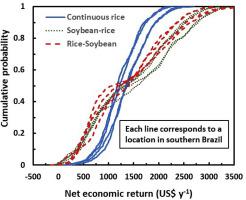Agricultural Systems ( IF 6.1 ) Pub Date : 2020-12-25 , DOI: 10.1016/j.agsy.2020.103036 Giovana Ghisleni Ribas , Alencar Junior Zanon , Nereu Augusto Streck , Isabela Bulegon Pilecco , Pablo Mazzuco de Souza , Alexandre Bryan Heinemann , Patricio Grassini

|
Lowland irrigated rice in southern Brazil is typically grown in monoculture, with one rice crop per year. However, during the past 10 years, some farmers have switched from the traditional continuous rice system to a 2-y soybean-rice rotation. Here we performed an on-farm assessment about the impact of introducing soybean to the lowland continuous rice system in southern Brazil. The goal was to determine how the soybean-rice rotation compared to continuous rice in terms of yield and profit. We used farmer-reported survey data collected from lowland rice-based systems in southern Brazil over three growing seasons. Cropping-system yield, profit, and return-to-inputs were compared between fields following continuous rice versus soybean–rice rotation. In addition to the survey data analysis, we evaluated the long-term economic impact of adopting the rotation using a combination of a crop simulation model and Monte-Carlo stochastic modeling. Average rice yield was 26% higher in the rotation compared to continuous rice. Besides the rotation effect, sowing date, N fertilizer, and weed management explained most of the field-to-field variability in rice yield. Cropping-system yield and gross income were lower in the soybean-rice rotation than in continuous rice as a result of replacing an irrigated crop (rice) by a water-limited rainfed crop (soybean). Despite that yield penalty, there was no difference in net economic return between the two cropping systems due to lower production costs in soybean-rice rotation compared to continuous rice. The rotation also exhibited smaller labor requirement and higher benefit-to-cost ratio and return to labor than continuous rice. Despite these potential benefits, our long-term analysis indicated higher inter-annual variability and economic risk in the rotation compared to continuous rice. Other factors further constrain adoption of the soybean-rice rotation, including the high risk of growing soybean in fields that are prone to excess water and difficulties to change current farm logistics. Findings from this study are relevant to other rice-based systems in the world looking for opportunities to increase or maintain net profit while reducing costs and/or labor.
中文翻译:

评估将大豆引入巴西南部低地水稻系统的产量和经济影响
巴西南部的低地灌溉稻米通常是单种种植,每年种植一种水稻。但是,在过去的10年中,一些农民已经从传统的连续水稻系统转换为2年制大豆-水稻轮作。在这里,我们对巴西南部低地连续稻系统中引入大豆的影响进行了农场评估。目的是确定就产量和利润而言,与连续水稻相比,大豆-水稻轮作如何。我们使用了农民报告的调查数据,这些数据是在三个生长季节从巴西南部的低地稻米系统中收集的。比较了连续稻田和田间稻田之间的种植系统的产量,利润和投入的回报大豆-水稻轮作。除了调查数据分析外,我们还结合了作物模拟模型和蒙特卡洛随机模型,评估了采用轮作的长期经济影响。与连续稻相比,轮作的平均稻产量高出26%。除了轮作效应外,播期,氮肥和杂草处理还解释了水稻产量在田间差异的大部分原因。由于用水灌溉的旱作作物(大豆)替代了灌溉作物(水稻),因此大豆大米轮作的农作系统单产和总收入均低于连续水稻。尽管有增产的惩罚,但由于与连续水稻相比,大豆-水稻轮作的生产成本较低,因此两种作物系统的净经济收益没有差异。与连续性水稻相比,轮作还显示出较少的劳动力需求,较高的成本效益比和返工率。尽管有这些潜在的好处,但我们的长期分析表明,与连续性水稻相比,轮作具有更高的年际变异性和经济风险。其他因素进一步限制了大豆大米轮作的采用,包括在水源过多和难以改变当前农场物流的田间种植大豆的高风险。这项研究的发现与世界上其他以稻米为基础的系统有关,它们正在寻找机会来增加或保持净利润,同时降低成本和/或劳动力。我们的长期分析表明,与连续水稻相比,轮作的年际变异性和经济风险更高。其他因素进一步限制了大豆大米轮作的采用,包括在水源过多和难以改变当前农场物流的田间种植大豆的高风险。这项研究的发现与世界上其他以稻米为基础的系统有关,它们正在寻找机会来增加或保持净利润,同时降低成本和/或劳动力。我们的长期分析表明,与连续水稻相比,轮作的年际变异性和经济风险更高。其他因素进一步限制了大豆大米轮作的采用,包括在水源过多和难以改变当前农场物流的田间种植大豆的高风险。这项研究的发现与世界上其他以稻米为基础的系统有关,它们正在寻找机会来增加或保持净利润,同时降低成本和/或劳动力。











































 京公网安备 11010802027423号
京公网安备 11010802027423号